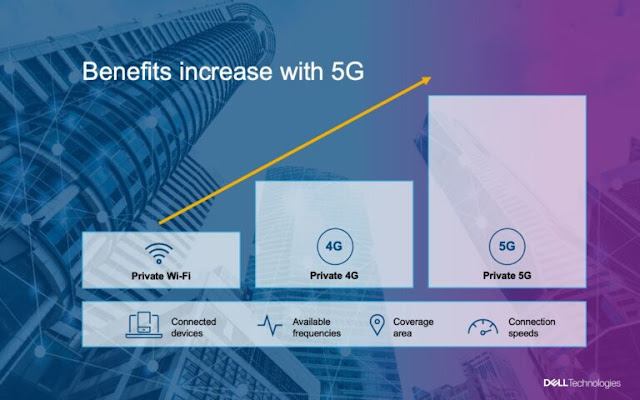Much has been said about the imperative for enterprises to automate operations and jump-start a new era of data-driven insight and near real time business decisions. Edge computing is a means to this end and an industry hot topic, as organizations of all kinds seek to act on data near the point of creation to generate immediate, essential value. That makes 5G a hot topic as well, since 5G enables exciting new use cases at the enterprise edge.
5G is much more than just the generation following 4G; it is a revolutionary communications upgrade that bridges IT and telecom infrastructures under a horizontal cloud-based architecture that enables unprecedented economies of scale. If that were not enough, 5G can use more frequency bands and deliver lower latency and higher throughput to connect virtually everyone and everything — including people, machines, objects and devices. It promises to drive the development of game-changing applications at the edge, enabling much more widespread use of Internet of Things (IoT), artificial intelligence and real time data analytics for effective decision making.
However, as promising as 5G is, the 5G transition will be much like other waves of technological change, where new generations of technologies enable new use cases but do not fully replace the previous generations. In today’s edge computing environments, 5G is moving in alongside 4G and Wi-Fi private wireless networks in a blended approach to connectivity that is optimized for each use case.

Private Wi-Fi
Organizations use Wi-Fi in many environments—for example, to connect users within campuses, manufacturing plants or remote and branch office and retail locations. Wi-Fi costs less than cellular systems, is straightforward to deploy and maintain and offers a multitude of compatible devices and a spectrum that does not require licensing. These characteristics make it ideal for small enterprises requiring general connectivity and less critical communications services that do not have intense security and reliability requirements.
Most enterprises currently have a private Wi-Fi network strategy in place and will transition to 4G or 5G only where the inherent drawbacks of Wi-Fi networks are impacting business outcomes. Drawbacks include the fact that Wi-Fi requires more access points compared to 4G and 5G, which can increase reliability issues and management complexity as the system scales. Signals are also subject to interference and are less secure and reliable than with 4G and 5G. In addition, users cannot transition seamlessly to other networks when they leave the Wi-Fi signal area.
Because of these drawbacks, organizations will add 4G or 5G connectivity in addition to Wi-Fi for use cases that require more devices, more security and reliability and faster, seamless connectivity across networks.
Private 4G LTE
Introduced in 2009, 4G long term evolution (LTE) delivers better speeds, security and reliability than Wi-Fi does. 4G is also interference-resistant and offers seamless mobility between on-premises access points and outside private or public networks. The energy efficient access points support many more simultaneously connected devices. However, 4G is more complex to deploy, operate and maintain than Wi-Fi is and has a limited spectrum available for enterprises.
Because 4G is a well-established standard with a vast and mature ecosystem of supported devices and applications, organizations will continue to use 4G for many enterprise use cases that are not suitable for Wi-Fi.
Private 4G networks can also be deployed on the Citizens Broadband Radio Service (CBRS) band, simplifying enterprise access to the 4G spectrum. However, as organizations expand their edge computing use cases and capabilities, connecting data from many thousands of devices and automating split-second responses, more use cases will transition to 5G.
Private 5G
For use cases that require high capacity, reliability, security and/or ultra-low latency, 5G is the standard of choice. It offers a 20X broader frequency spectrum and is highly interference resistant. As the most advanced standard, 5G currently has a maturing device ecosystem; however, most new implementations will use 5G going forward, which will rapidly diminish this disadvantage. Most industry communications players are strongly supporting the formation of a 5G device ecosystem.

With abundant spectrum being assigned for 5G use around the world, we will see private 5G shine as the default standard of choice for enterprises. The latest iteration of 5G, recently released by the 3rd Generation Partnership Project (3GPP), allows 5G operation in unlicensed bands. Various regulators around the world will permit 5G to use the 6GHz unlicensed band, unleashing a whopping amount of spectrum easily accessible by enterprises. Spectrum-demanding use cases, such as holographic communications, 3D quality inspection, augmented reality/virtual reality (AR/VR) and near real-time video processing, will be at the hands of enterprises enabling their digital transformation.
Furthermore, 5G is particularly well suited for environments using enormous amounts of IoT devices. Its flexible resource assignation enables thousands of edge devices to interconnect with computing systems to return instantaneous insights.
Enterprises — make your plans to incorporate 5G
5G is essential to the enterprise digital transformation journey. Enhancements in the recent 3GPP release 16, and the upcoming release 17, include extensions to existing features, as well as features that enable enterprises to address new use cases and deployment scenarios and even the potential for new verticals to form. Operation in the unlicensed spectrum, intelligent transportation systems, industrial IoT and non-terrestrial networks (satellites, unmanned aerial vehicles and high-altitude platforms) are just a few of the new capabilities addressed by new releases of 5G. And more new capabilities are on the 3GPP drawing board.
Many 5G-enabled use cases are emerging, and 5G implementations will live alongside existing and new generations of Wi-Fi and 4G for some time. Right now, adopting a flexible infrastructure that is ready to adapt to future use cases — many of which cannot be predicted today — is a solid approach that will prepare you for mainstream adoption of 5G and what comes next.
Source: delltechnologies.com






0 comments:
Post a Comment